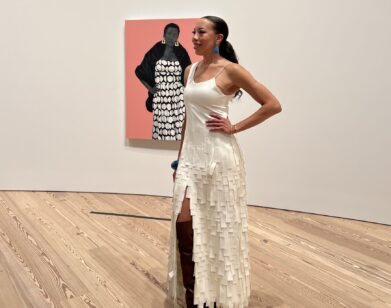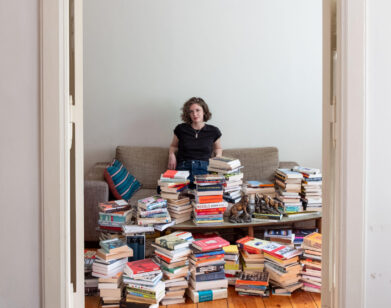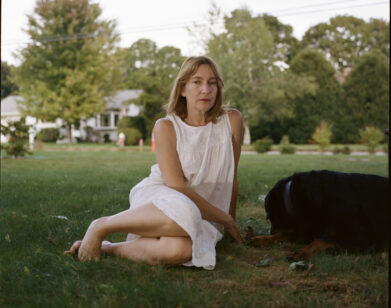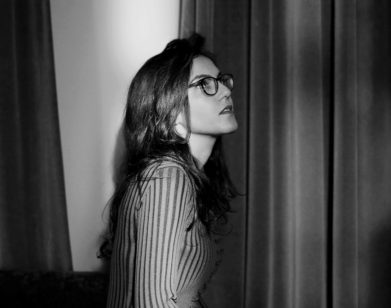OPENING
Na Kim Designs Your Favorite Book Covers. Now She’s Painting For Herself.
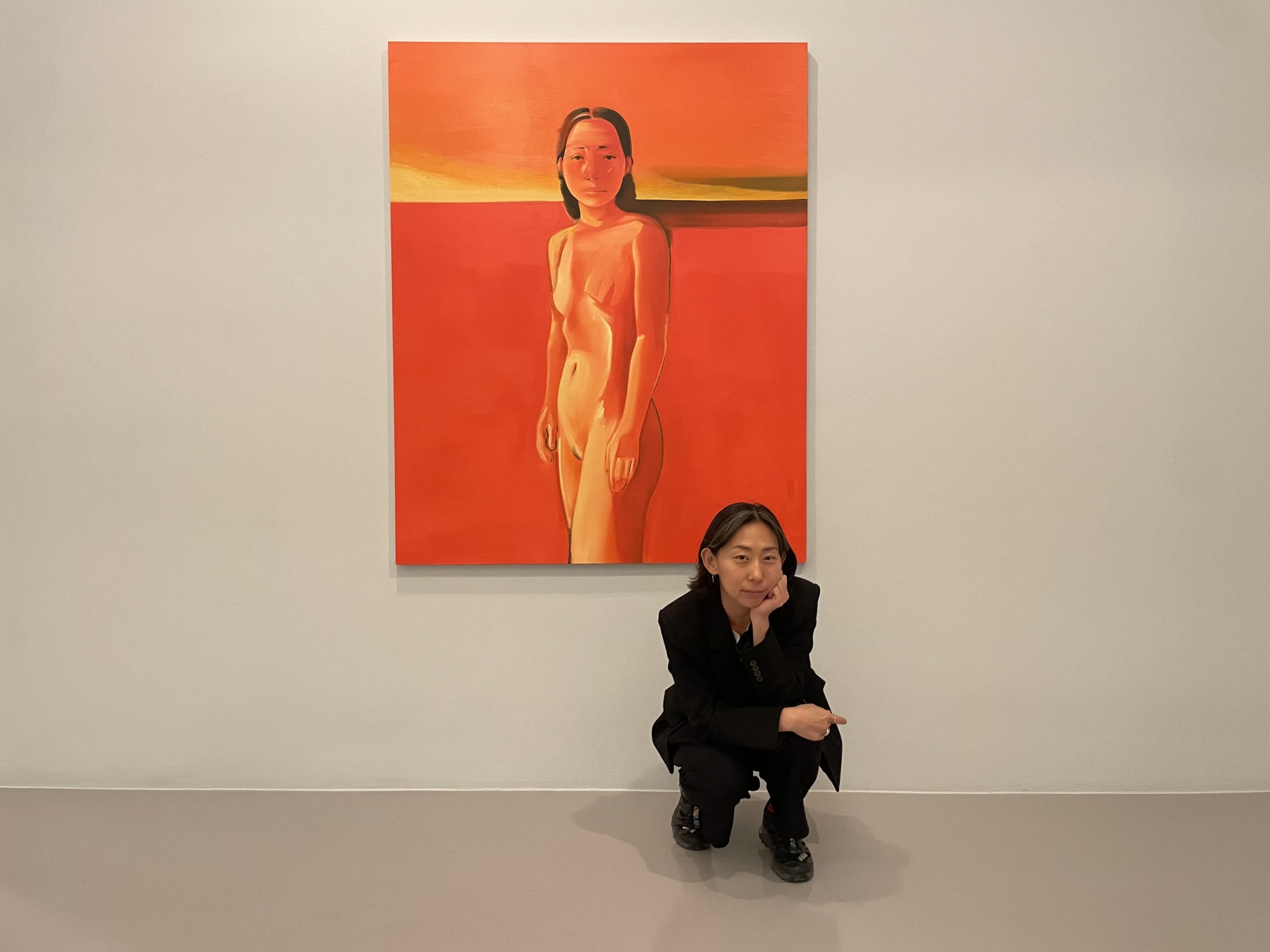
Na Kim, photographed by Maria Owen.
“I thought we already did this,” insists Na Kim as I attempt, a second time, to find out what inspired her to pursue painting on top of two other prestigious posts as Art Director at The Paris Review and Creative Director at publishing house Farrar, Strauss, and Giroux. “It’s been the thing I’ve wanted to do since I was a wee, wee girl,” she says, before confessing that witnessing an ex-boyfriend pursue his own artistic ambitions added further fuel to the fire. From painting to throwing killer dinner parties to designing some of the most memorable book covers of the last several years, Kim’s practice is rooted in dedication, self-restraint, and simply doing the work. But she picks and chooses what she’s most disciplined about. “Not things like nicotine or martinis,” she quips. “And I can’t get myself to sign up for an exercise class if it saved my fucking life.”
Kim’s latest exhibition, Memory Palace, opened last week at Nicola Vassell Gallery, elaborating on an ongoing series where a familiar face is rearranged in seemingly infinite compositions. It’s obvious that Kim can move paint, but beyond her carefully honed skill is a meticulous understanding of psychology and a sensitivity to emotion. The main gallery is rhythmically arranged with dozens of portraits, guiding the viewer through with gestures of a turned head or shoulder. Three variations on a swimming figure transform the back gallery into a shadowed lagoon. After meeting for an exhibition walkthrough, we hopped in a cab to the Chelsea Hotel for dinner, where Kim passed on a 10-ounce ribeye in favor of subtler fare and allowed me to desperately interrogate her about hard work, ambition, and being a multi-hyphenate.
———
MARIA OWEN: We just walked through your show at Nicola Vassell and now we’re at the Chelsea Hotel having dinner. What did you order?
NA KIM: I got some gambas, some tomato bread, and olives.
OWEN: I’m getting hungry.
KIM: I’m starving.
OWEN: It’s also the eve of your opening. How do you feel going into the show?
KIM: I try not to have any expectations. You know me, I like to keep the bar low for myself. I hope people see it, but beyond that, not much.
OWEN: I remember last year somebody asked you what you thought about being an artist after the career you’ve had in design, and you said that you don’t really see yourself that way. Do you still feel like that’s true?
KIM: I don’t know, I still feel shy about it.
OWEN: Why?
KIM: Imposter syndrome. I feel like maybe I didn’t earn the right to call myself an artist at that point.
OWEN: Was there a point in design where you didn’t experience imposter syndrome anymore?
KIM: Yeah, it took me about 10 years. For the first 10 years, I kind of thought I would just get fired every day no matter what.
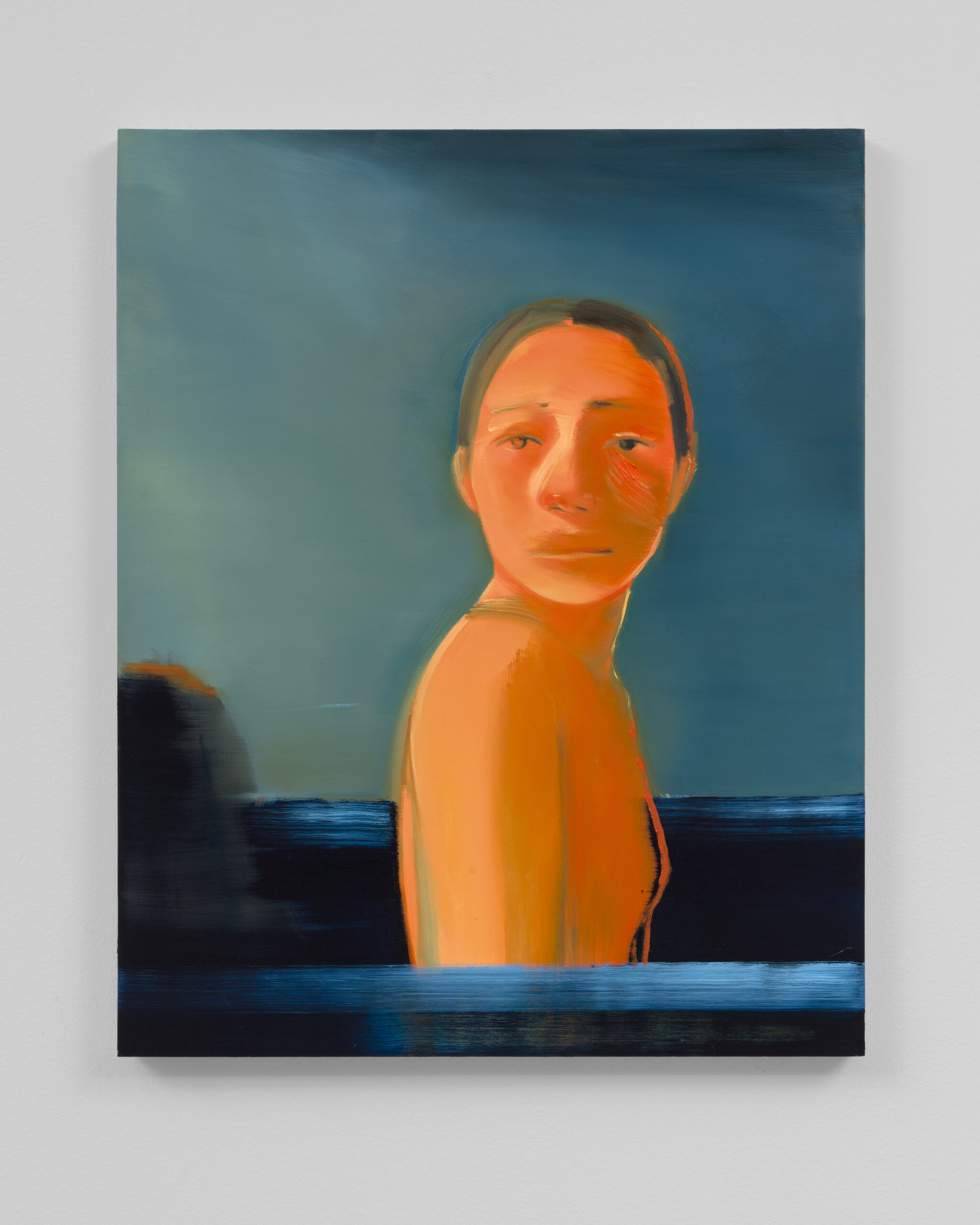
Untitled: 5, 2024. Oil on linen. 30 x 24 in. 76.2 x 61 cm. ©Na Kim. Courtesy of the artist and Nicola Vassell Gallery. Photo: Lance Brewer.
OWEN: What changed?
KIM: I guess I felt like I’ve done enough good work, and that I’m an adult now. I’m trying to bring a little more confidence into my day to day, but it’s difficult.
OWEN: Was there a job that you did or a project you worked on where you remember really feeling proud of it? You’ve also designed some pretty iconic book covers.
KIM: Yeah, but it’s not really my work. It’s not about me. It’s about the author, it’s their book. But I feel really lucky that I get to work on a lot of amazing books for authors who I admire.
OWEN: But it’s your job to accurately articulate the essence of the piece.
KIM: Correct.
OWEN: Which I’m sure can be challenging at times?
KIM: But it’s like, a job. A job is a job.
OWEN: But what does the process look like?
KIM: Read the book, hopefully come up with some ideas, take what the author wants into consideration and try to make the best version of that as I possibly can.
OWEN: Are you looking at a lot of references?
KIM: I try not to look at other designer’s work. I think it’s so easy to rip things off that I don’t want to tempt myself.
OWEN: Do writers ever send you things that you have to distance yourself from? Like, “Oh, I really like the way this looks. Can you do something similar?”

Untitled: 1, 2024. Oil on linen. 60 x 48 in. 152.4 x 121.9 cm. ©Na Kim. Courtesy of the artist and Nicola Vassell Gallery. Photo: Lance Brewer.
KIM: Yeah and you have to approach it very carefully, I think. Because it’s a small industry and we all know when people rip things off, we just don’t say it out loud.
OWEN: We don’t always say it.
KIM: But we know.
OWEN: Have you ever designed a cover for a book that you really didn’t like?
KIM: Yes.
OWEN: Did you like the cover?
KIM: Hated the cover. Hated the book.
OWEN: Are you going to tell me which book?
KIM: It’s not where I work now. It was a freelance cover.
OWEN: Have you always painted?
KIM: No, I started painting about two years ago.
OWEN: And what inspired that?
KIM: I don’t know. Maybe I was just tired of watching everybody else follow their dreams and I wasn’t doing the same. So I thought, “Why not?” Then I gave it a go. I didn’t have any aspirations about it. I was just doing it for myself, trying to figure out why I was so afraid of it.
OWEN: Have you figured it out yet?
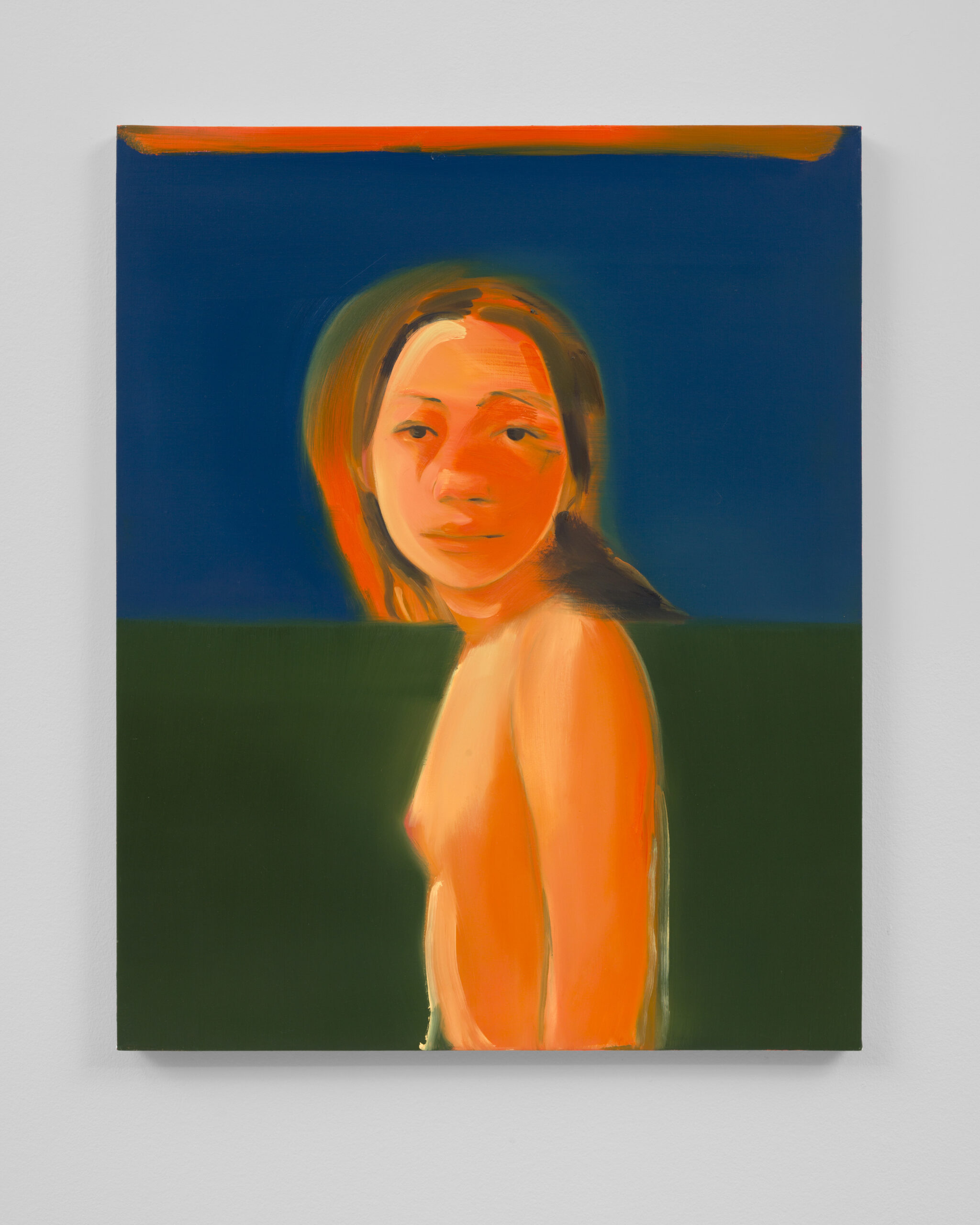
Untitled: 9, 2024. Oil on linen. 30 x 24 in. 76.2 x 61 cm. ©Na Kim. Courtesy of the artist and Nicola Vassell Gallery. Photo: Lance Brewer.
KIM: Well, I’m not afraid of it anymore. These gambas are fucking good.
OWEN: Would you say you’re a disciplined person?
KIM: I didn’t think I was, but I must be.
OWEN: You’ve become one, maybe?
KIM: I pick and choose what I’m disciplined about, I think.
OWEN: What are some other things that you’re disciplined about?
KIM: Anything work-related, but maybe not things like nicotine or martinis. And I can’t get myself to sign up for an exercise class if it saved my fucking life.
OWEN: I want to talk about publishing personalities, art world personalities–
KIM: Don’t get me in trouble.
OWEN: Do you have any qualms about either industry? Is there something you like about one or the other?
KIM: You’re going to get me in trouble. There are many things I like about both.
OWEN: Do they overlap?
KIM: Well, I think a really nice aspect of publishing is the collaborative aspect. I think people really care about the work and it’s a lot of people coming together to make one single vision come together, and I like playing my role in that. The art world, I’m so new to it, so I’m not really sure. I’m just excited to be here and seeing how it goes.
OWEN: Why did you start painting? What motivated you?
KIM: I thought we already just did this.
OWEN: We tried, but you wiggled out.

Detail from Untitled: 17, 2024. Oil on linen. 24 x 24 in. 61 x 61 cm. ©Na Kim. Courtesy of the artist and Nicola Vassell Gallery. Photo: Lance Brewer.
KIM: Okay. I’ve always wanted to paint. It’s been the thing I’ve wanted to do since I was a wee, wee girl. It’s either that or become a doctor, and I got one year of really bad grades, so I gave up on becoming a doctor and I went to art school because they gave me money to go. But then I decided I couldn’t really afford the luxury of becoming a painter, so I gave up on it, yada, yada, yada. Years later, I see that somebody I used to date who I encouraged to paint was now a fucking painter. And I was like, “This guy is living my fucking dream. What the fuck?” It was really disturbing to me at that moment. I was like, “How come I can encourage and support this person, but I can’t do it for myself?” And then when I started painting, I was also dating another painter and I was watching him live my dream and I just thought, “Well, why not? Let’s just do it.”
OWEN: Is there anything else you have always wanted to try but are afraid to?
KIM: Writing.
OWEN: Writing?
KIM: Yeah. But honestly, I’m arguing with myself about this because I really do think anyone could do anything if they work hard at it. You get better at things if you actually try them. So I don’t want to say that I can’t become a better writer, but I don’t know that I would ever become a good writer. I don’t really know if it’s one of my strengths.
OWEN: I guess reading so many manuscripts, you encounter a lot of things that are intimidatingly good, but there must also be things that you read where you’re like, “Okay, I feel like I could match this.”
KIM: Right, but why start writing to be a bad writer? That’s so stupid. I’m going to stick to painting right now.
OWEN: You also throw excellent dinner parties. What’s the secret? What does every dinner party need?
KIM: It’s three things. Okay? Number one, the company. You invite the right mix of people. People who don’t know each other is a good idea. Two, I think you should keep your menu very limited. I think you should focus on making one main really good dish and a good salad with maybe some good bread. Three, I think for one night, and one night only, you allow indoor smoking. And I think people are just so thrilled by the opportunity to be bad. It’s very easy.
OWEN: Are you doing anything to take care of yourself or unwind?
KIM: I’m getting a facial on Friday from a place I haven’t gone before, so I’m scared.
OWEN: Were you a fan of The Paris Review before you started working there?
KIM: 100%, yeah. Love The Paris Review.
OWEN: I know you said you don’t look at just other designers’ work, but do you ever think about how things have been done there historically? Or do you try to keep it really fresh?

Installation view of Memory Palace. ©Na Kim. Courtesy of the artist and Nicola Vassell Gallery. Photo: Lance Brewer.
KIM: We’re looking at the whole catalog, mostly using it as a standard. Just being like, “Okay, what’s going to be exciting and new, but still fit the billing standard of what The Paris Review does and represents?” It’s a pretty big challenge, because there have been some really amazing issues and covers, but we try our best. We’re not reflecting what’s happening in the world. It’s about good work and good literature. I don’t think the covers really reflect what’s inside either.
OWEN: Have you worked with anyone who’s given you any particularly good advice or guidance?
KIM: I’ve gotten so much good advice. I feel like that’s one of the things I’m luckiest with. My boss once said to me, “Be careful what you’re good at, you’re going to get stuck doing that.” And I think about it a lot, and I thought about it a lot when I was getting into painting. It’s like, “What kind of painting do I want to make that I’m not going to get sick of making in a year, or 10 years, 20 years, or 30 years?” You just have to make the work that you want to make and that will feel true, and I think good things come from that. And not every piece has to be a masterpiece either. You’ve got to make some bad paintings so you can make good paintings, right? Because I paint every day, because I’m exploring one subject with these boundaries, it opens up a lot of possibilities and it helps me be less precious about the work. And it’s not boring to me to paint the same thing every day, because the results are so different. It’s life, baby. You’ve got to enjoy the ride.
OWEN: You do.
KIM: I still don’t know what to wear tomorrow.
OWEN: What are you thinking?
KIM: I feel like a lot of people have this dilemma before a party. You’re always negotiating, “Do I want to look cool or do I want to look hot?”
OWEN: What are you leaning toward?
KIM: Honestly, I’m just going to go for it. I’m 38. I don’t have many more years of being able to pull this shit off.

